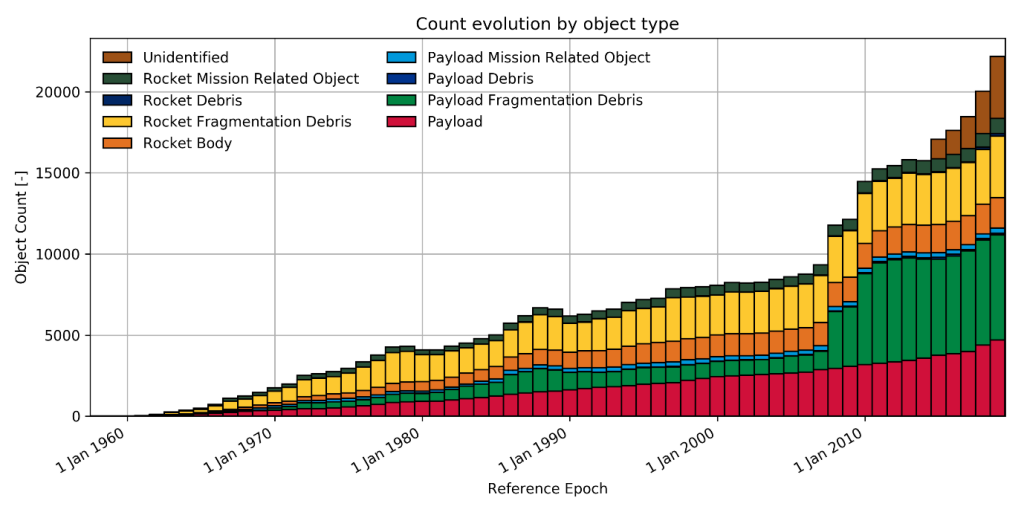Space Traffic. An imminent threat to human space exploration?
The Kessler Syndrome is the phenomenon of the creation of space junk by the cascading effect of collision of existing space debris to create more debris, once a certain threshold of the amount of space junk orbiting the Earth has surpassed. Such an event in the orbit around Earth would render the Earth’s orbit unusable and unsustainable for future space missions. China’s Yunhai-1 (02) satellite suffered from a breakup event on March 18, 2021, recently linked to a collision with small debris (1996-051Q) associated with the Russian Zenit-2 launch vehicle, according to the 18th Space Control Squadron (18 SPCS) of the US Space Force. To date, the break up of Yunhai-1 (02) has generated 37 fragments from the collision out of which 4 have re-entered the atmosphere, according to the 18 SPCS of the US Space Force. Nevertheless, this recent incident highlights the need and importance of a Space Traffic Management (STM) system to ensure safe and reliable access to space.
The issue of space debris is of course neither new nor theoretical. Every year, with the addition of new satellites and fragmentation of active and inactive satellites in already congested orbits, the risks of collision events has increased more than ever. The ISS, as well as many other objects in LEO, frequently perform collision avoidance manoeuvres, which nevertheless cannot fully protect from damages being caused, as in the case of the ISS Canadarm2. While most, if not all, spacefaring nations recognise space debris as a crucial issue to be addressed, instruments of soft law and best practices are the only current mechanisms for mitigation.
In June 2021, delegates of Canada, France, Germany, Italy, Japan, the USA, the UK and the EU, at the G7 Leaders’ Summit in Cornwall, pledged to take concerted action to tackle “the growing hazard of space debris as our planet’s orbit becomes increasingly crowded.” The G7 partners published a joint statement committing themselves to the protection of the safety and sustainability of outer space and recognising the planet’s orbits as a fragile and valuable environment. The statement was welcomed by international observers as a major milestone, such as the UNOOSA (United Nations Office for Outer Space Affairs).
Exhibit 1 Damage from space debris on the Canadarm2 [Image Credit: NASA/CSA][1]

International standards such as the IADC’s Space Debris Mitigation Guidelines of 2007 (signed by all leading spacefaring states) encourage actors to avoid intentionally generating new orbital debris as well as minimising the potential for accidental fragmentation of satellites. In addition, satellites in LEO should abide by a rule requiring them to be deorbited within 25 years after completion of their mission. While the 25-year rule has been restated by the updated orbital mitigation guidelines by the US in late 2019, its validity has been questioned, with many arguing that due to the frequency with which new satellites are being deployed in orbit, the time frame for disposal should be lowered to 5-10 years after mission completion. The current long time frame is compounded by little compliance with the mitigation guidelines, as ESA estimated that only between 5-20% of payloads in LEO would not naturally deorbit within the 25-year timeframe successfully carry out deorbiting operations. On the one hand, instances of successful soft law have given rise to best practices or (in time) to the development of customary international law. On the other hand, these instruments of soft law tackling space debris mitigation have trudged and stagnated.
With these concerns in mind, and in the absence of binding international regulations, the safety and sustainability of outer space in the short- and mid-term rests upon space-faring countries’ technical and diplomatic capabilities to effectively coordinate and manage space traffic.
Exhibit 2: Total orbital debris by type [Source: ESA[2]]

The avoidance of collisions in orbit and a consequent Kessler Syndrome in the future will require an international effort, whether under the auspices of existing bodies such as UNOOSA or the ITU, or through the creation of a new one. Due to the nature of both the space sector and outer space itself, concerted international undertakings are required to effectively manage a large-scale STM system with annexed international regulations, definitions, and technical standardisations.
To learn more about EUSTM, visit our About page, and to get in touch and help us shape the sustainable future of the European space sector, contact us directly or subscribe to our newsletter below.
 | This project has received funding from the European Union’s Horizon 2020 research and innovation programme under grant agreement No 101004319. This article reflects the author’s view and not necessarily the views of the European Commission or of the European Health and Digital Executive Agency |